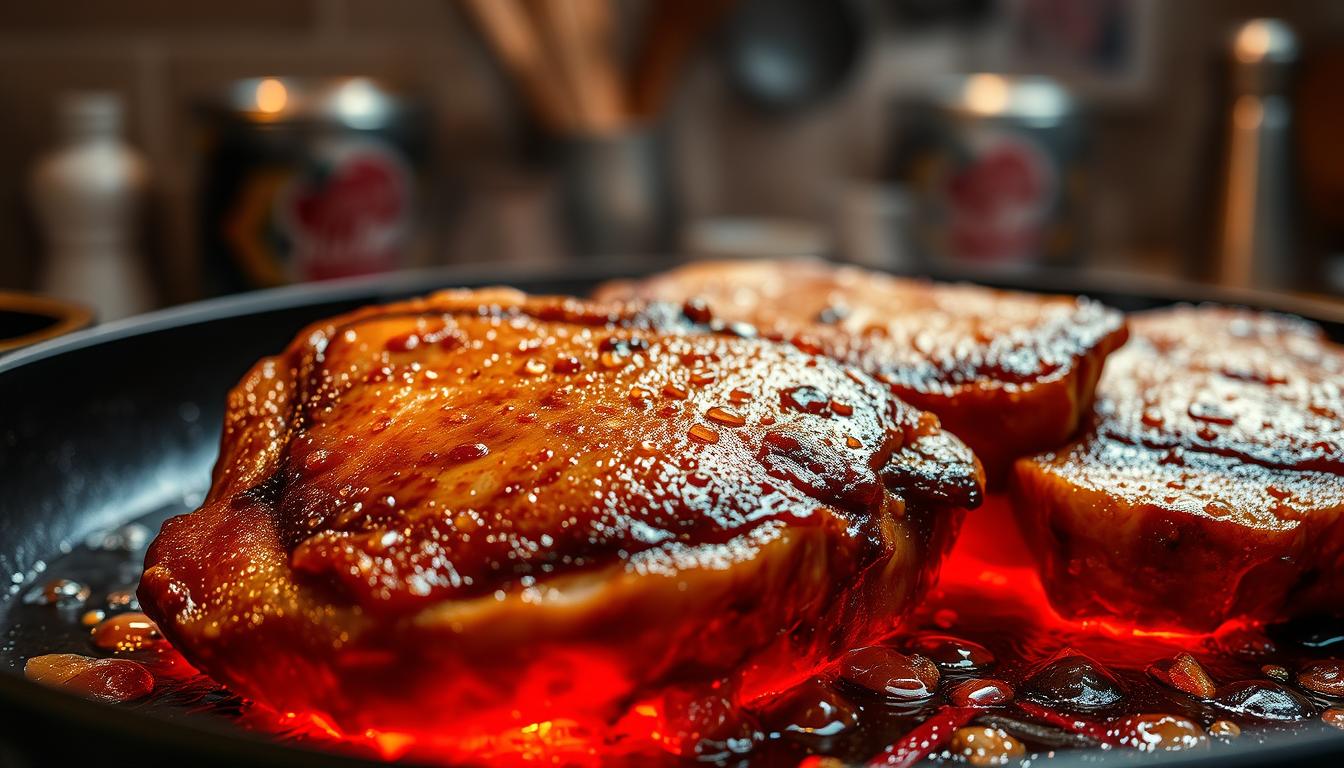Over 30% of home cooks accidentally dry out their proteins due to misunderstood heat management. The difference between succulent and tough results lies in how muscle fibers interact with heat. When proteins cook, they contract and squeeze out moisture – but strategic techniques can prevent this.
Understanding protein structure unlocks the secret to retaining natural juices. Muscle tissues contain water-holding proteins and collagen that transform during cooking. Proper temperature control slows moisture loss while enhancing flavor development through caramelization.
Different cuts demand unique approaches. Thicker steaks benefit from reverse searing, while poultry thrives with brine solutions. Even your seasoning timing affects juiciness – salt applied too early can draw out moisture prematurely.
Key Takeaways
- Protein structure determines moisture retention during cooking
- Collagen breakdown creates natural juiciness in slow-cooked meats
- Precise temperature control prevents muscle fiber over-tightening
- Brining and marinating enhance water retention capabilities
- Resting time allows juices to redistribute evenly
- Fat content and marbling influence natural moisture levels
Introduction: Unlocking Juicy Meat Secrets

Professional chefs guard their culinary secrets like treasure, but today you’ll discover the science behind succulent proteins. Moisture retention isn’t magic – it’s about balancing heat application with natural tissue chemistry. Whether you’re grilling steaks or roasting poultry, the principles remain consistent across cooking methods.
“Perfect texture comes from respecting the meat’s structure, not overpowering it with heat.”
Three elements determine your success: protein behavior, temperature precision, and preparation timing. Thicker cuts like ribeye demand different handling than delicate chicken breasts. This table reveals how common proteins respond to various techniques:
| Protein Type | Optimal Temp | Key Technique |
|---|---|---|
| Beef Steaks | 130°F | Reverse sear |
| Chicken Breast | 165°F | Brine soak |
| Pork Chops | 145°F | Dry rub |
Notice how resting periods allow juices to redistribute – skip this step, and you’ll lose up to 40% moisture. Brining solutions work by altering cell structure through osmosis, while marinades break down tough fibers. Your choice between wet and dry methods depends on cooking time and desired flavor intensity.
Master these fundamentals, and every dish becomes an opportunity to impress. The following sections will transform theoretical knowledge into practical kitchen mastery.
Understanding the Science Behind What Makes Meat Juicy
The key to tender, moist results lies in the microscopic world of muscle composition. Three-dimensional protein networks act like sponges, trapping water molecules between their folds. When heat disrupts these structures, moisture escapes – unless you intervene strategically.

Protein Behavior Under Heat
Myosin and actin proteins dictate texture more than any seasoning. These muscle components tighten at specific temperatures – myosin at 104°F, actin at 150°F. Slow cooking keeps their contraction gradual, preserving natural juices.
Baking soda demonstrates this science practically. By raising surface pH levels, it weakens protein bonds. This creates space for moisture retention, especially in lean cuts like chicken breast.
Structural Integrity Matters
Collagen-rich tissues transform differently than tenderloin fibers. The table below shows how various factors influence texture:
| Factor | Effect | Optimal Range |
|---|---|---|
| pH Level | Enhances water-binding | 7.2-7.8 |
| Heat Duration | Softens collagen | 160°F/6hrs |
| Salt Timing | Prevents moisture loss | 45min pre-cook |
Muscle fibers arranged in tight bundles resist juice penetration. Mechanical tenderizing or enzymatic marinades help overcome this. Your cooking method must match the cut’s inherent structure.
Remember: water follows protein movement. Control the contraction, and you control the juiciness. This principle applies whether you’re roasting, grilling, or stir-frying.
Exploring Different Cuts of Meat and Their Impact on Juiciness
Selecting the right cut transforms your cooking results more than any seasoning blend. Each piece contains unique fat patterns and muscle structures that dictate moisture retention. Bone-in options like cutlets conduct heat differently than boneless sirloin, directly affecting juice distribution.

Prime Cuts for Moisture Retention
Entrecote stands out with its signature fat marbling. These streaks melt during cooking, naturally basting the meat from within. High loin cuts take this further with deeper fat infiltration – perfect for slow roasting.
| Cut | Fat Content | Best Method | Juiciness Factor |
|---|---|---|---|
| Sirloin | Low | Grill | 8/10 |
| Entrecote | Medium | Pan-sear | 9/10 |
| High Loin | High | Roast | 10/10 |
| Cutlet | Variable | Braise | 7/10 |
Optimizing Compact Portions
Smaller cuts like cubed beef demand quick cooking at high heat. Sear surfaces immediately to lock in juices. For stir-fries, slice against the grain – this shortens muscle fibers for easier chewing.
Bone-in options require adjusted cooking times. The connective tissue near bones breaks down into gelatin, creating natural sauce bases. Always pat surfaces dry before cooking to ensure proper browning.
Mastering Cooking Techniques for Ultimate Juiciness
Heat management separates average cooks from kitchen maestros. Your choice of cooking method directly impacts how proteins retain moisture during preparation. Let’s explore techniques that turn ordinary cuts into extraordinary meals.
Pan Searing and Temperature Control

A blistering-hot pan creates instant surface caramelization. This Maillard reaction forms a protective crust that seals in juices. For perfect results:
- Preheat cast iron or stainless steel pans for 5 minutes
- Test heat with water droplets – they should dance, not sizzle out
- Sear steaks 2 minutes per side before finishing in the oven
| Method | Optimal Temp | Best For |
|---|---|---|
| Pan Searing | 400°F+ | Beef steaks, pork chops |
| Smoking | 100-240°F | Pork butt, brisket |
| Baking | 325-375°F | Chicken thighs, roasts |
Grilling, Baking, and Other Methods
Low-and-slow approaches work wonders for tougher cuts. Smoking pork butt at 225°F for hours breaks down collagen without drying fibers. Delicate proteins like fish fillets thrive under precise oven heat.
Grilling requires constant attention. Create two zones – sear over direct flames, then move to cooler areas. This prevents surface burning while ensuring thorough cooking.
Enhancing Flavor with Brining and Dry Brining Methods
Transform tough cuts into tender masterpieces through strategic salt applications. Brining methods enhance moisture retention while amplifying natural flavors. Whether prepping ribs for smoking or chicken breasts for grilling, these techniques adapt to your schedule and protein type.

Benefits of Dry Brining with Baking Soda
Dry brining revolutionizes meat preparation for time-crunched cooks. Simply rub 1% of your protein’s weight in baking soda across its surface – a 5-pound roast needs 0.8 ounces. Refrigerate for 3-5 hours to let the alkaline soda work its magic.
This method raises surface pH levels, weakening protein bonds. The result? Up to 15% better moisture retention during high-heat cooking. Ideal for thick pork chops or beef ribs, dry brining requires no messy liquid solutions.
Quick Wet Brining Techniques for Tender Meat
Submerge smaller cuts in a saltwater solution for rapid flavor infusion. A basic brine combines ¼ cup kosher salt with 4 cups water. Chicken thighs need just 2 hours in this mixture to achieve juicy results.
| Method | Prep Time | Best For | Key Ingredient | Texture Effect |
|---|---|---|---|---|
| Dry Brining | 3-24 hours | Large roasts | Baking soda | Crispy exterior |
| Wet Brining | 1-4 hours | Poultry breasts | Sea salt | Uniform tenderness |
“Brining unlocks hidden potential in every cut – it’s like giving proteins a hydration insurance policy before cooking.”
Balance salt concentration carefully – too much creates rubbery textures. Always refrigerate during brining to prevent bacterial growth. Choose dry methods for crispy-skinned results, wet solutions for quick poultry prep.
What Makes Meat Juicy Through Effective Tenderizing Methods
Your knife should glide through proteins like butter – tenderizing methods make this possible. While quality cuts matter, proper preparation turns budget-friendly options into restaurant-worthy dishes. Chemical and mechanical approaches alter muscle structure at microscopic levels.

Velveting Magic: Baking Soda’s Hidden Power
Velveting revolutionizes stir-fries and quick-cook dishes. Coat beef or chicken chunks with ¾ teaspoon baking soda per pound. Let sit 15 minutes – the alkaline solution weakens protein bonds. Rinse thoroughly to prevent bitter aftertaste.
This technique creates a protective layer that locks in moisture during high-heat cooking. Ground proteins benefit too – mix ¼ teaspoon baking soda per pound before browning. Results? Juicy tacos and moist meatballs every time.
Tenderizing Showdown: Method Comparison
Different proteins demand unique approaches. Pounding works for thin cuts, while enzymatic marinades suit fibrous meats. See which method fits your needs:
| Technique | Best For | Time Required | Texture Result |
|---|---|---|---|
| Velveting | Stir-fry meats | 15-30 min | Silky smooth |
| Pounding | Chicken breasts | 5 min | Even thickness |
| Enzymatic | Tough steaks | 2-4 hrs | Butter-soft |
“Velveting turns economical cuts into luxury ingredients – it’s the ultimate kitchen hack for busy cooks.”
Remember: Over-tenderizing creates mushy textures. Follow timing guidelines precisely. Pair methods with proper cooking temperatures for optimal moisture retention. Your proteins will stay succulent from first bite to last.
Innovative Marinades and Natural Tenderizers
Nature provides powerful tools to enhance texture and taste in protein preparation. Enzymatic fruits and plant-based solutions offer alternatives to commercial tenderizers while boosting moisture retention. These methods work with your protein’s natural chemistry rather than against it.
Using Fruit Juices, Tea, and Coffee for Tenderness
Pineapple and papaya contain enzymes that break down tough fibers without compromising structure. Marinate chicken breasts in fresh pineapple juice for 30 minutes – the bromelain enzyme softens tissues while adding subtle sweetness. For beef stew, try kiwi puree mixed with soy sauce; its actinidin enzyme works twice as fast as commercial powders.
Black tea doubles as a flavor enhancer and tenderizer. Steep two tea bags in boiling water, then chill the liquid. Submerge pork chops for 4 hours – tannins relax muscle fibers while infusing earthy notes. Cold-brew coffee proves even more effective, with acids that penetrate deep into compact cuts like chuck roast.
Enhancing Flavor with Herbs, Spices, and Vinegar
Acidic components like apple cider vinegar create tenderizing effects while carrying herbal flavors into proteins. Combine ¼ cup vinegar with rosemary and garlic for a quick poultry marinade. The acid opens cell structures, letting aromatics seep deeper into chicken thighs or drumsticks.
Balance marinating times carefully:
- Fruit-based solutions: 30 minutes to 2 hours
- Tea/coffee baths: 2-4 hours
- Vinegar mixtures: 1-3 hours
“Natural tenderizers work best when you respect their active windows – timing turns good intentions into exceptional results.”
For stew meats, blend pomegranate juice with cumin and coriander. The fruit’s enzymes soften collagen during slow cooking, while spices develop complex layers in the broth. Always pat proteins dry before cooking to ensure proper browning and flavor concentration.
Expert Tips for Quick and Effective Meat Tenderizing
Perfecting protein texture starts before heat touches the pan. Strategic preparation steps ensure even cooking and maximum moisture retention. These professional techniques adapt to any schedule while delivering consistent results.
Pre-Cooking Preparations and Timing
Remove proteins from refrigeration 30-60 minutes before cooking. This simple step prevents thermal shock that forces moisture out. For thicker cuts like roasts, extend resting time to 90 minutes for uniform temperature distribution.
Pat surfaces thoroughly with paper towels. Dry exteriors promote better browning while locking in natural juices. Use this time to preheat cooking equipment – consistent heat application prevents uneven texture.
Optimal Use of Salt and Seasonings
Apply salt 45 minutes before cooking for ideal absorption. The mineral penetrates deep into tissues, enhancing flavor without drawing out moisture. For quick-cook dishes, use coarse salt just before searing to create a protective crust.
Balance seasoning layers by adding herbs after dry brining. This preserves their aromatic qualities while letting salt work its tenderizing magic. Always let cooked proteins rest 5-10 minutes – this crucial process allows juices to redistribute evenly.



